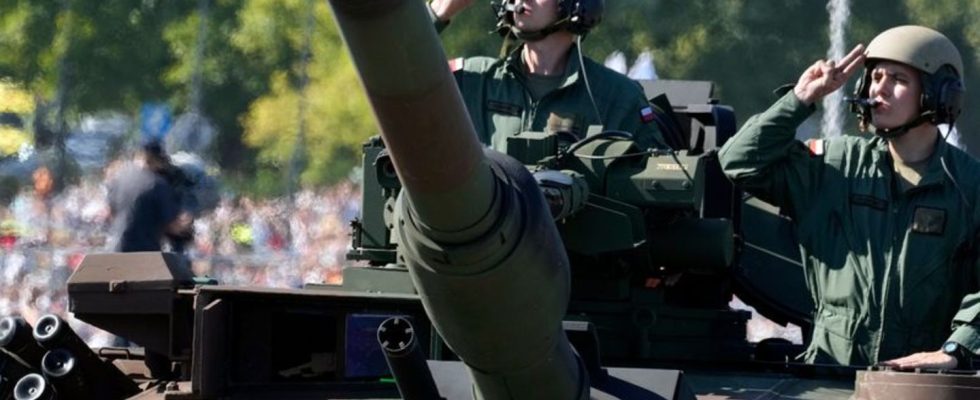defense
Frontline state Poland demonstrates strength with a military parade
The holiday commemorates the victory over Soviet Russia in the 1920 Battle of Warsaw during the Polish-Soviet War. photo
© Czarek Sokolowski/AP/dpa
The NATO country Poland feels threatened by Russia and is massively rearming. The army is expected to almost double in size in the coming years. Many new weapons were presented at the military parade.
In the heat of midsummer in Warsaw, Piotr (32) managed to find a shady spot. Here he stands, his little son Michal on his shoulders, and looks spellbound at the passing soldiers, tanks and howitzers. The computer scientist from Breslau (Wroclaw) and his family are dedicated to the Military parade traveled to the Polish capital.
“It’s good that we’re showing that we’re prepared to defend our country,” he says, referring to Russia’s war of aggression against Poland’s neighbor Ukraine.
It is the first time after a break of several years due to the pandemic that a military parade will be held in Warsaw on “Army Day”. With the war in Ukraine, the issue of defense suddenly became a central issue in Polish society. Thousands of people crowd the meadows along the parade route, they have come with prams, dogs and picnic blankets to marvel at war technology.
Poland is arming massively
The EU and NATO country Poland is not only one of the biggest military supporters of Ukraine – it is also arming itself massively against a possible threat from Russia. The nervousness has increased recently because of the activities of Russian Wagner mercenaries in neighboring Belarus.
The parade is intended to demonstrate internally and externally: Poland has the right to become an important military power in Eastern Europe. The army is said to almost double in size. The armed forces currently number 172,500 men and women, including tens of thousands in the volunteer homeland security organizations. In the coming years there should be 300,000 including Homeland Security. In order to achieve this, a large image campaign was launched for the “Wojsko” (army), which used to be ridiculed by the population. If you like, you can learn to shoot at free military citizen training courses.
This year, the country wants to spend four percent of its economic output on defense – NATO had set itself a goal of two percent in peacetime. Poland has signed billion-euro deals with the US and South Korea to modernize its army and air force.
Last summer Warsaw ordered 48 FA-50 fighter jets from South Korea to replace older Soviet-built aircraft. Also 180 K2 main battle tanks, 24 of which have already been delivered. A second tranche will include 800 tanks, some of which will already be manufactured in Poland. In addition, the Polish army will receive 48 South Korean K9 self-propelled howitzers to replace guns that have been transferred to Ukraine. Another 600 howitzers are to be delivered from 2024, from 2026 also with production in Poland.
Billions for arms deals
The country bought a total of 366 US Abrams main battle tanks from the US, including 250 of the latest version that have not yet been delivered and 116 of the older version used. As early as 2020, Poland ordered 32 American F-35 fighter jets from the USA – this arms deal alone was worth the equivalent of 4.2 billion euros. In addition, there are almost 700 multiple rocket launcher systems of the US type Himars and the South Korean equivalent Chunmoo.
“We will have more rocket launchers and tanks than Germany and France put together,” writes the daily Gazeta Wyborcza with a mixture of pride and horror. The national-conservative governing party PiS has also taken up the issue of defense in the election campaign before the parliamentary elections on October 15. Hardly a day goes by without Defense Minister Mariusz Blaszczak making an appearance. The military parade also serves this purpose. “The Poles should take a look at all the military hardware, convince themselves of the growing strength of the army under the PiS and make the only right decision at the ballot box,” Polityka magazine scoffed.
Meanwhile, many Poles are wondering who should pay for the gigantic costs of the rearmament. The strongman in Polish politics, PiS boss Jaroslaw Kaczynski, has a simple answer: “It’s better to be in debt than occupied,” he said in an interview.

